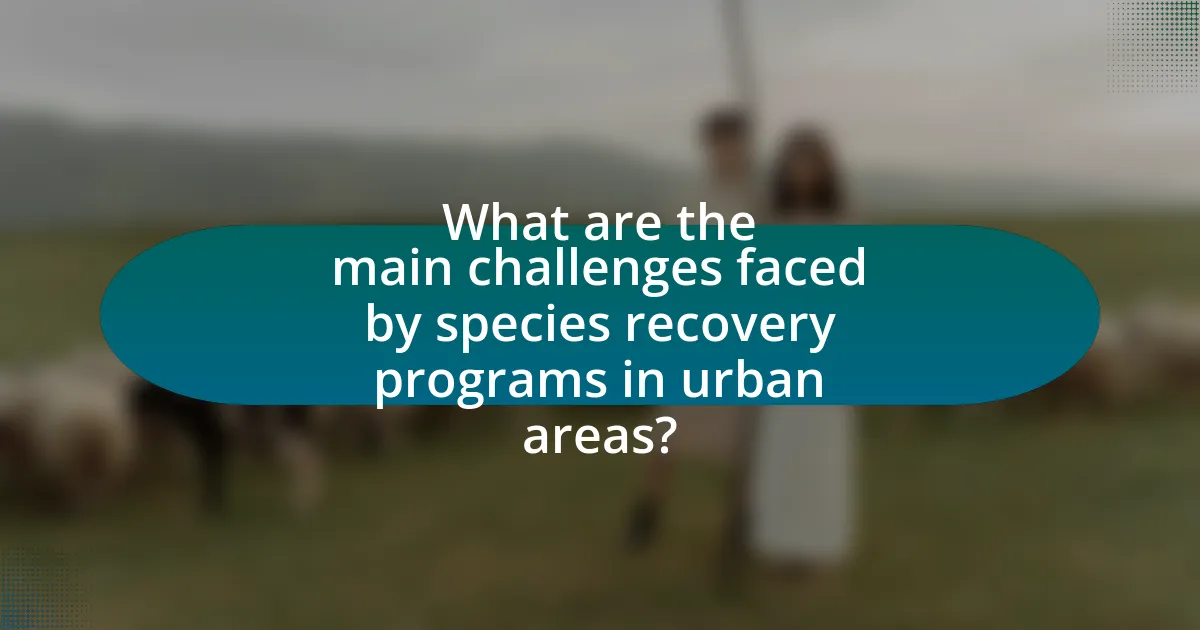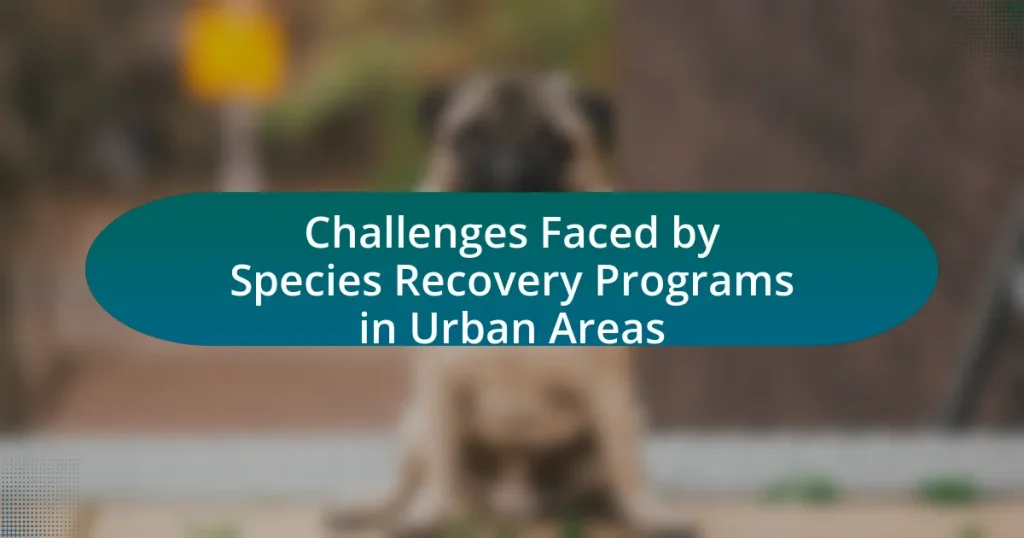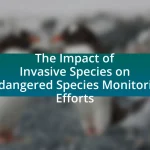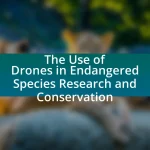Species recovery programs in urban areas encounter significant challenges, primarily due to habitat loss, pollution, and human-wildlife conflict. Urbanization leads to habitat fragmentation, reducing available space for species and hindering their ability to find food and mates. Pollution further threatens species survival, while human disturbances disrupt natural behaviors. The article explores specific urban factors affecting recovery efforts, the importance of public awareness and community engagement, financial challenges, regulatory frameworks, and innovative strategies to enhance conservation outcomes. It emphasizes the need for integrated urban planning and collaboration among stakeholders to improve species recovery in urban environments.

What are the main challenges faced by species recovery programs in urban areas?
Species recovery programs in urban areas face significant challenges primarily due to habitat loss, pollution, and human-wildlife conflict. Urbanization leads to the fragmentation of habitats, making it difficult for species to find food, mates, and shelter. For instance, a study by the National Audubon Society highlights that urban development has reduced available habitats for many bird species by over 50% in some regions. Additionally, pollution from vehicles and industrial activities can degrade air and water quality, further threatening species survival. Human-wildlife conflict arises as urban areas encroach on natural habitats, leading to increased encounters between humans and wildlife, often resulting in negative outcomes for both. These factors collectively hinder the effectiveness of recovery efforts and the long-term sustainability of species in urban environments.
How do urban environments impact species recovery efforts?
Urban environments significantly hinder species recovery efforts due to habitat fragmentation, pollution, and human disturbances. Habitat fragmentation in cities reduces the available space for species to thrive, leading to isolated populations that struggle to reproduce and maintain genetic diversity. For instance, studies show that urbanization can decrease the habitat quality for many species, resulting in a decline in their populations. Pollution from urban areas, including air and water contaminants, further exacerbates the challenges faced by recovering species, as these pollutants can affect their health and reproductive success. Additionally, human activities such as construction, traffic, and recreational use of natural areas create disturbances that can displace wildlife and disrupt their natural behaviors. Collectively, these factors create a challenging environment for species recovery programs, making it difficult to achieve successful conservation outcomes in urban settings.
What specific urban factors hinder species recovery?
Specific urban factors that hinder species recovery include habitat fragmentation, pollution, and human disturbance. Habitat fragmentation occurs when urban development divides ecosystems into smaller, isolated patches, making it difficult for species to find mates and resources. Pollution, such as chemical runoff and noise, negatively impacts species health and behavior, reducing their chances of survival and reproduction. Human disturbance, including recreational activities and urban expansion, disrupts natural habitats and can lead to increased mortality rates among vulnerable species. These factors collectively create significant barriers to the successful recovery of species in urban environments.
How does urbanization affect habitat availability for species?
Urbanization significantly reduces habitat availability for species by transforming natural landscapes into urban environments. This transformation leads to habitat fragmentation, where continuous habitats are divided into smaller, isolated patches, making it difficult for species to find food, mates, and migrate. According to a study published in the journal “Ecological Applications,” urban areas can reduce available habitat by up to 75%, severely impacting biodiversity and species survival. Additionally, urbanization introduces barriers such as roads and buildings, further limiting species movement and access to resources.
Why is public awareness important for species recovery in urban settings?
Public awareness is crucial for species recovery in urban settings because it fosters community engagement and support for conservation efforts. When the public is informed about the importance of biodiversity and the specific needs of endangered species, they are more likely to participate in initiatives such as habitat restoration, reporting wildlife sightings, and advocating for policies that protect these species. Studies have shown that community involvement can significantly enhance the success rates of recovery programs; for instance, a report by the National Wildlife Federation indicates that urban wildlife conservation efforts that include public education and participation lead to a 30% increase in local species populations. Thus, raising awareness not only mobilizes resources but also cultivates a culture of stewardship that is essential for the long-term sustainability of species recovery in urban environments.
What role does community engagement play in recovery programs?
Community engagement plays a crucial role in recovery programs by fostering collaboration between stakeholders, which enhances the effectiveness of conservation efforts. Engaged communities contribute local knowledge, increase awareness, and promote stewardship, leading to more sustainable practices. For instance, studies have shown that programs involving community participation can improve habitat restoration outcomes by up to 30%, as local residents often have valuable insights into the ecological dynamics of their area. Additionally, community involvement can lead to increased funding and resources, as engaged citizens are more likely to support initiatives financially and advocate for policy changes that benefit recovery efforts.
How can education initiatives improve species recovery outcomes?
Education initiatives can improve species recovery outcomes by increasing public awareness and engagement in conservation efforts. When communities are educated about local species and their ecological importance, they are more likely to participate in recovery programs and support conservation policies. For instance, studies have shown that community-based education programs can lead to a 30% increase in local participation in species monitoring and habitat restoration activities. Furthermore, informed citizens can advocate for sustainable practices that reduce habitat destruction, thereby directly benefiting species recovery efforts.
What are the financial challenges associated with urban species recovery programs?
Urban species recovery programs face significant financial challenges, primarily due to limited funding sources and high operational costs. These programs often rely on grants, donations, and governmental support, which can be inconsistent and insufficient to cover the comprehensive needs of recovery efforts. For instance, a study by the National Fish and Wildlife Foundation indicates that urban conservation projects frequently encounter budget shortfalls, leading to inadequate habitat restoration and species monitoring. Additionally, the high costs associated with urban land acquisition and management further strain financial resources, making it difficult to implement effective recovery strategies.
How do funding limitations affect program implementation?
Funding limitations significantly hinder program implementation by restricting resources necessary for effective operation. When financial support is inadequate, species recovery programs struggle to hire qualified personnel, conduct essential research, and execute conservation activities. For instance, a study by the National Oceanic and Atmospheric Administration (NOAA) found that insufficient funding led to delays in habitat restoration projects, ultimately impacting species survival rates. Additionally, limited funds can result in reduced outreach and education efforts, which are crucial for community engagement and support. Consequently, these financial constraints can compromise the overall success and sustainability of species recovery initiatives in urban areas.
What strategies can be employed to secure funding for recovery efforts?
To secure funding for recovery efforts, organizations can employ strategies such as building partnerships with local businesses, applying for government grants, and engaging in crowdfunding campaigns. Partnerships with local businesses can provide financial support and resources, as businesses often seek to enhance their community image and fulfill corporate social responsibility goals. Government grants are available through various agencies focused on environmental conservation, and applying for these requires a well-structured proposal that outlines the recovery program’s objectives and expected outcomes. Crowdfunding campaigns leverage social media and community engagement to attract small donations from a large number of people, which can be particularly effective for grassroots initiatives. These strategies have been successfully implemented in various recovery programs, demonstrating their effectiveness in securing necessary funding.
How do regulatory frameworks influence species recovery in urban areas?
Regulatory frameworks significantly influence species recovery in urban areas by establishing legal protections and guidelines that govern habitat conservation and restoration efforts. These frameworks, such as the Endangered Species Act in the United States, mandate the identification and protection of critical habitats, which are essential for the survival and recovery of threatened species. For instance, when urban development projects are proposed, regulatory assessments often require environmental impact studies that evaluate potential harm to local wildlife, thereby promoting measures to mitigate negative effects. Furthermore, compliance with these regulations can lead to the allocation of funding and resources for habitat restoration initiatives, enhancing the chances of species recovery in urban settings.
What are the key regulations affecting species recovery programs?
The key regulations affecting species recovery programs include the Endangered Species Act (ESA), the National Environmental Policy Act (NEPA), and the Migratory Bird Treaty Act (MBTA). The ESA provides a framework for the conservation of threatened and endangered species and their habitats, mandating federal agencies to ensure that their actions do not jeopardize these species. NEPA requires federal agencies to assess the environmental impacts of their proposed actions, which can influence species recovery efforts by necessitating thorough environmental reviews. The MBTA protects migratory birds by regulating the taking, killing, or possession of these species, thereby impacting recovery strategies for avian populations. These regulations collectively shape the policies and actions taken to support species recovery in urban areas, where habitat loss and human activities pose significant challenges.
How can policy changes support better recovery outcomes?
Policy changes can support better recovery outcomes by implementing regulations that enhance habitat protection and restoration in urban areas. For instance, establishing green corridors and protected zones can facilitate species movement and access to resources, which is crucial for their survival. Research indicates that urban biodiversity can be significantly improved through policies that promote native vegetation and limit urban sprawl, as seen in studies conducted by the Urban Ecology Institute, which found that cities with strong biodiversity policies had 30% higher species richness compared to those without. Additionally, integrating community engagement in policy-making can foster public support for recovery initiatives, leading to more effective conservation efforts.
What innovative approaches are being used to overcome challenges in urban species recovery?
Innovative approaches to overcome challenges in urban species recovery include the use of green infrastructure, habitat restoration, and community engagement initiatives. Green infrastructure, such as green roofs and urban parks, provides essential habitats for various species, enhancing biodiversity in densely populated areas. Habitat restoration projects, like rewilding urban spaces and creating wildlife corridors, facilitate species movement and access to resources. Community engagement initiatives, including citizen science programs and educational campaigns, empower local residents to participate in conservation efforts, fostering a sense of stewardship and increasing public support for recovery programs. These strategies have been shown to improve species survival rates and promote ecological resilience in urban environments.
How can technology aid in monitoring and supporting species recovery?
Technology aids in monitoring and supporting species recovery through tools such as remote sensing, GPS tracking, and data analytics. Remote sensing allows researchers to gather large-scale environmental data, which helps identify habitat changes and assess ecosystem health. GPS tracking provides real-time location data on species movements, enabling conservationists to understand migration patterns and habitat use. Data analytics processes this information to identify trends and predict future challenges, facilitating targeted conservation efforts. For instance, a study published in “Ecological Applications” by McClintock et al. (2018) demonstrated how GPS collars on endangered species improved survival rates by informing habitat management strategies.
What role do partnerships play in enhancing recovery efforts?
Partnerships play a crucial role in enhancing recovery efforts by facilitating collaboration among various stakeholders, including government agencies, non-profit organizations, and local communities. These collaborations enable the pooling of resources, expertise, and data, which are essential for effective species recovery programs. For instance, partnerships can lead to the sharing of best practices and innovative strategies, as seen in the recovery of the California condor, where collaboration between the U.S. Fish and Wildlife Service and various conservation organizations significantly improved population numbers. Additionally, partnerships foster community engagement, which is vital for garnering public support and participation in recovery initiatives, ultimately leading to more sustainable outcomes.
What best practices can be adopted for successful species recovery in urban areas?
Successful species recovery in urban areas can be achieved through habitat restoration, community engagement, and policy support. Habitat restoration involves creating green spaces, such as parks and urban gardens, which provide essential resources for wildlife. Community engagement fosters local stewardship, encouraging residents to participate in conservation efforts, as seen in initiatives like the Million Trees NYC program, which planted over one million trees to enhance urban biodiversity. Policy support, including zoning regulations that protect natural habitats and promote sustainable development, is crucial; for instance, the Urban Wildlife Conservation Program by the U.S. Fish and Wildlife Service emphasizes integrating wildlife conservation into urban planning. These practices collectively enhance the viability of species recovery in urban settings.
How can urban planning integrate species recovery initiatives?
Urban planning can integrate species recovery initiatives by incorporating biodiversity considerations into land-use policies and development projects. This integration can be achieved through the establishment of green corridors, which connect fragmented habitats, allowing for species movement and genetic exchange. For instance, cities like Melbourne have implemented urban green spaces that support local wildlife, demonstrating that urban environments can coexist with natural ecosystems. Additionally, zoning regulations can prioritize the preservation of critical habitats, ensuring that development does not encroach on areas vital for species recovery. Studies show that urban areas designed with ecological principles can enhance species diversity and resilience, thereby supporting recovery efforts.
What lessons have been learned from successful urban recovery programs?
Successful urban recovery programs have demonstrated the importance of community engagement and collaboration among stakeholders. Engaging local communities fosters ownership and ensures that recovery efforts align with the needs and values of residents, which has been shown to enhance program effectiveness. For instance, the recovery of the California gnatcatcher involved local residents in habitat restoration efforts, leading to increased public support and successful species recovery. Additionally, successful programs emphasize the integration of ecological, social, and economic factors, as seen in the revitalization of urban green spaces that support biodiversity while providing recreational opportunities for residents. These lessons highlight that a holistic approach, combining ecological restoration with community involvement, is crucial for the success of urban recovery initiatives.


